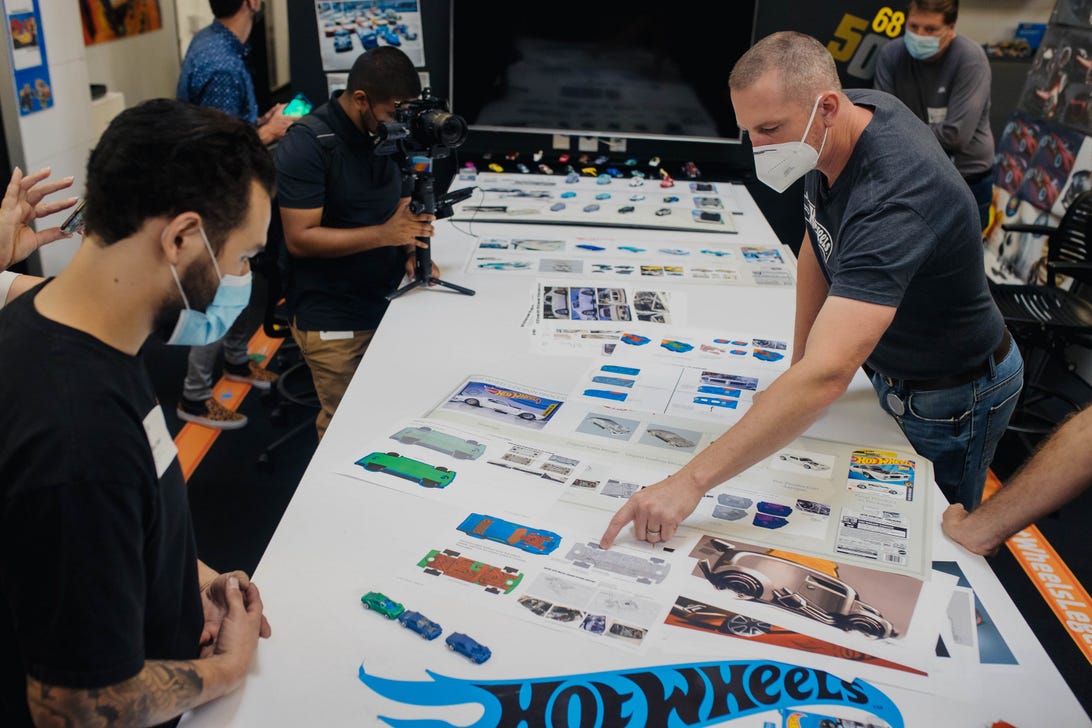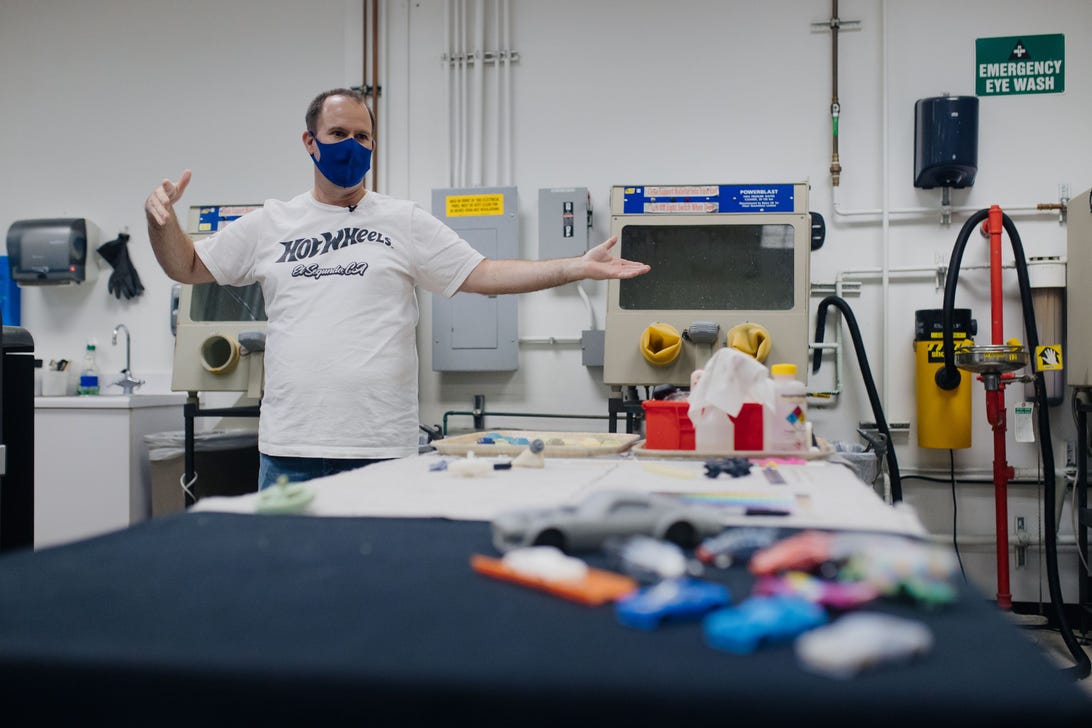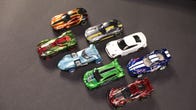Going from a 1,000-horsepower, home-built 1970 Pontiac Trans Am to a 1/64-scale toy involves a lot more steps than you might think.
Race ServiceThe odds are good that at some point in your life you've come across a Hot Wheels toy car. If you're a car enthusiast, you've probably had a collection of them at some point, or maybe you have one now, but have you ever really sat and thought about how they're made? How does Mattel take a full-size car and turn it into a 1/64-scale toy?
To find out how the process works, we went to Hot Wheels design headquarters in El Segundo, California, to watch the winner of the 2020 Hot Wheels legends tour go through it. The winner, an epic 1970 Pontiac Trans Am track car built by Riley Stair in his family's side yard, presented some interesting challenges for the crew from Mattel, but the end result was worth it.
The first stage of the process involves figuring out what car you're going to make. In the Trans Am's case, it was selected as the winner of the 2020 Hot Wheels Legends tour, which is essentially a traveling car show that sets up in Walmart parking lots, and people are encouraged to enter their garage-built cars. The grand prize is getting a Hot Wheels toy based on your car.
The second step is collecting photo references so that the designers and sculptors have something on which to base their work. In the case of Riley's Trans Am, this was easy because there are photos of it everywhere. Those photos get turned into a sketch by the lead designer for the project, which can stretch or change some of the proportions to make the car work better in 1/64 scale and to start the process of making sure it can be die-cast accurately.

The process starts with a whole lot of sketches and design iteration in 2D.
Race ServiceFrom there, the sketches, along with the photo reference, go to the sculpting department. Earlier in Hot Wheels history, this would have been done with wooden bucks, but to modernize and speed up the production process, Hot Wheels switched to in-house digital modeling in 2007. Hot Wheels uses something called digital clay in a program called Freeform. Unlike other more traditional digital models that use wireframes, Freeform treats the object being worked on as a solid piece of material rather than a skin over a skeleton.
In the case of Riley's car, the sculptor-- Mason Cheung -- interacts with the computer using a stylus on an arm that provides haptic feedback as he carves the digital clay. This technology was initially developed and is still used to train surgeons without the need for them to cut on actual cadavers. Hot Wheels has become the largest user of the technology since it began, far surpassing its original intended market.
I was allowed to try the stylus myself, and not only does it provide resistance as you carve through the digital clay, but it will fall into divots and holes, and detect edges such as the roof edge above the windshield. It's hard to describe precisely how it feels to use the system, but Cheung provided the best analogy by saying that it's like scooping watermelon.
The digital clay process has other benefits, aside from its speed. It allows you to set the clay's resolution, which will enable you to be sure that any detail that's carved -- such as the open engine bay with its chassis tubes or the NACA ducts on the rear window -- can be recreated in metal in the die casting process. If you've seen a brand-new production Hot Wheels car, the results speak for themselves.

This machine was designed to train surgeons; now it lets sculptors work with "digital clay."
Race ServiceOnce the car has been sculpted digitally, it's sent through a revisions process to ensure that the details are correct and that the right parts are emphasized. Part of that revisions process involves 3D printing so that the designers have actual physical objects to compare with the real car. The Mattel 3D printing lab handles all of the rapid prototyping for everything from Hot Wheels to Barbie.
With consumer-grade printers, there are two main technologies at work. There's FDM (fused deposition modeling), which heats a plastic filament and squirts it out like a hot glue gun, and photopolymerization, which uses UV light to cure a resin. Mattel primarily uses the latter, but it employs two main types of photopolymerization: stereolithography and polyjet.
The stereolithography system uses a vat of resin and two high-power military-grade lasers to create the printed object. The lasers (one broad and one fine) cure a shallow layer of resin per pass and are best for creating larger objects. These objects are printed with a disposable support structure that is broken away after the print is finished, similar to the FDM process.
The Objet Polyjet system functions much like your inkjet printer at home. It uses nozzles to deposit a thin layer of material on a build surface, and then a high-power UV light sweeps across it, curing that layer. The Polyjet system has several benefits, including its lack of reliance on a resin support structure. Instead, the Polyjet uses a water-soluble support gel that can be washed off. The added benefit of this is that it allows you to print moveable parts all at once, like a gearset or even a chain, without needing to assemble it later. The most advanced Polyjet that Mattel uses can print up to eight different materials at once, meaning that complex color patterns -- even camouflage -- can be incorporated right into the print. It's a little mind-blowing, if I'm honest.

The Mattel 3D printing lab allows for rapid prototyping of just about anything the designers can cook up, even complex moving parts.
Race ServiceAfter the cars are test-printed, they are then track-tested. This involves setting the cars into a jig designed to check their size and dimensions to make sure they'll fit on a Hot Wheels toy track and that they'll be able to complete a loop. The test jig is also 3D-printed. The track testing includes making sure the cars are compatible with the various boosters, be they hand-powered or motorized, designed for straights or a boost around a corner.
From there, they get sent down a very carefully calibrated track with set dimensions to determine how well they fare against other models. Interestingly, the various factories worldwide also have these tracks, also built to the same exacting specifications to spot-test during production. Finally, there is the more fun track that starts several stories up and goes through multiple loops, culminating in a booster and a jump. This isn't really meant to prove anything, but it sure is fun to play with.
Once all of the design revisions are finished and signed off on, Mattel then sends them to its various factories throughout Asia for tool creation and production. Hot Wheels cars are cast in a metal blend called Zamak, which is an acronym for the German names of the metals involved: "Zink (zinc), Aluminium, Magnesium and Kupfer (copper)."
The paint scheme and decals are applied using a process known as Tampo or pad printing. This is a printing method that screens a design onto a soft silicone pad that's then pressed onto the die-cast metal, leaving a repeatable, uniform coat of paint in a single step.

The end result of all this work and passion is a surprisingly faithful recreation of someone's extremely awesome car.
Race ServiceNow that we've got a cast and painted toy car, it needs to be put into its retail packaging, and designing that packaging is decidedly more complex these days than it has been for Hot Wheels in the past. Hot Wheels used the same basic retail packaging for all its toys for a long time, but now it designs individual cards for each model with art of the vehicle and information about the car, including who designed it.
The packaging design starts with the digital clay model and the design sketches, which are sent to any number of artists outside of Mattel to be turned into what's known as a "gray model." This gray model typically shows the car as a front three-quarters with the same wheels that the toy will have, and not necessarily the wheels that are on the actual car. There is another revisions process, and that gray model is given its final color and graphics. The car's background will change depending on what collection it's a part of, too.
Once the card art is done, the rest of the layout is locked in for each of the three types of individual car packaging. One is for the US; there's another that features five other languages that can be used elsewhere in the world, and finally, there's a smaller version that only has the legal copy on it, which can be sold anywhere. The packaging design process typically takes between four and six weeks.
From there, the car enters production, and several months later, they start arriving on store shelves. Producing a new Hot Wheels model is an extensive process that takes a lot of people with a great deal of talent, but for kids and collectors around the world, and especially for people like Riley Stair, the results are worth it.
Our day culminates in the official presentation of the very first production Hot Wheels version of Riley's Trans Am and seeing the two side by side; it's incredible the level of detail and accuracy that the Hot Wheels Team can put into a tiny toy car that's ultimately going to sell for around a dollar, though that does go a long way toward explaining why Hot Wheels makes the world's best-selling toys.
Hot Wheels are a lot more high-tech than you might expect
See all photos"car" - Google News
August 27, 2021 at 08:00AM
https://ift.tt/3jhEabg
Turning a real car into a Hot Wheels toy takes a lot of tech - CNET
"car" - Google News
https://ift.tt/2SUDZWE
https://ift.tt/3aT1Mvb
Bagikan Berita Ini















0 Response to "Turning a real car into a Hot Wheels toy takes a lot of tech - CNET"
Post a Comment